
Browse an alphabetical list of photographs. These historical images portray people, places, and events before, during, and after World War II and the Holocaust.
<< Previous | Displaying results 2201-2225 of 2641 for "Photo" | Next >>
At left, a column of Soviet prisoners of war, under German guard, marches away from the front. Place uncertain, July 1, 1941.
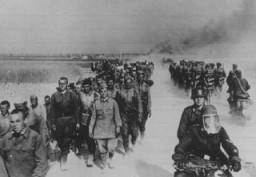
Soviet prisoners of war wait for food in Stalag (prison camp) 8C. More than 3 million Soviet soldiers died in German custody, mostly from malnutrition and exposure. Zagan, Poland, February 1942. Second only to the Jews, Soviet prisoners of war were the largest group of victims of Nazi racial policy.
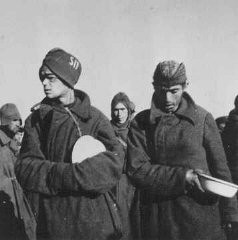
Soviet soldiers guard the entrance to Adolf Hitler's underground bunker. Upon the advance of Soviet forces through the streets of Berlin, Hitler committed suicide here on April 30, 1945, rather than face capture. Berlin, Germany, 1945.
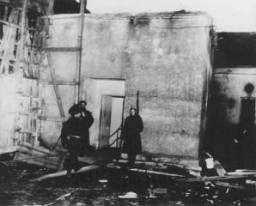
Soviet soldiers in a street in the Soviet occupation zone of Berlin following the defeat of Germany. Berlin, Germany, after May 9, 1945.
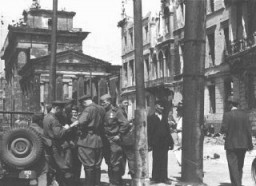
Soviet soldiers in a street in the Soviet occupation zone of Berlin following the defeat of Germany. Berlin, Germany, after May 7, 1945.
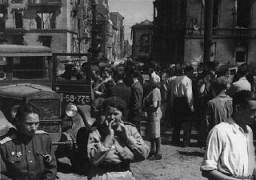
Soviet soldiers in the Soviet occupation zone of Berlin following the defeat of Nazi Germany. Berlin, Germany, after May 9, 1945.
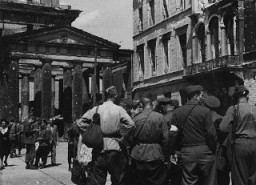
Soviet soldiers inspect a box containing poison used in medical experiments. Auschwitz, Poland, after January 27, 1945.
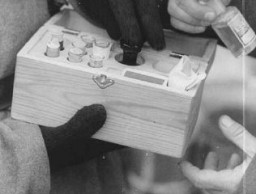
Soviet tanks roll down a street in Vienna during the Soviet conquest of the Austrian capital at the end of World War II. Photograph taken by Yevgeny Khaldei. Vienna, Austria, 1945.
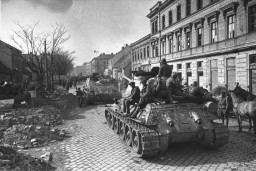
Soviet troops trample a Nazi flag as they march past a burning house on a street in the outskirts of Vienna. Photograph taken by Soviet photographer Yevgeny Khaldei. Vienna, Austria, April 1945.
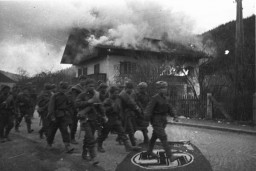
Cheering spectators greet Hitler upon his departure for the Reichstag session at which the Enabling Act was passed. The act allowed the government to issue laws without the consent of Germany’s parliament, laying the foundation for the complete Nazification of German society.
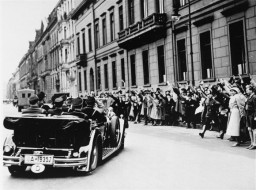
In the Olympic Stadium, German spectators salute Adolf Hitler during the Games of the 11th Olympiad. Berlin, Germany, August 1936.
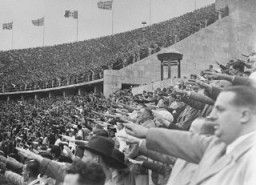
The Nazis used public displays to spread their ideas of race. The chart shown here is titled "The Biology of Growth," and is labeled "Stages of Growth for Members of the Nordic Race."
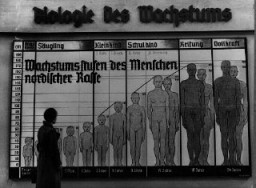
SS and Nazi police prepare for a raid on the Jewish community offices in Vienna. Austria, March 18, 1938.
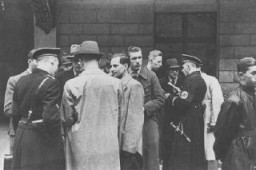
SS and Police Leader Juergen Stroop interrogates two Jews arrested during the Warsaw ghetto uprising. Poland, April 19-May 16, 1943.
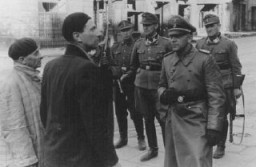
SS chief Heinrich Himmler addresses a group of soldiers in a cavalry regiment of the Waffen SS in the eastern territories. 1942.
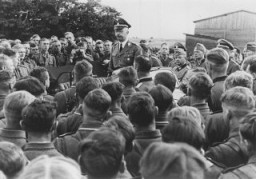
SS chief Heinrich Himmler (right) during a visit to the Auschwitz camp. Poland, July 18, 1942.
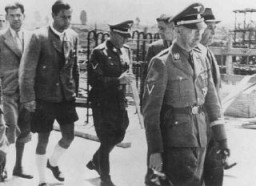
An official visit of Heinrich Himmler to the Lodz ghetto. Mordechai Chaim Rumkowski, head of the Jewish council, greets the Nazi officials. Lodz, Poland, June 5, 1941.
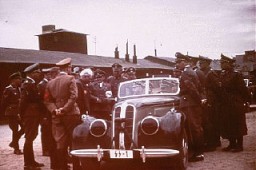
SS Colonel Franz Ziereis, commandant of the Mauthausen concentration camp in Austria.
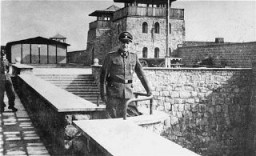
SS female auxiliaries show with mock sadness that they have finished eating their blueberries, July 22, 1944. From the Hoecker Album of 116 photographs taken during the last six months of Auschwitz, between June 1944 and January 1945.
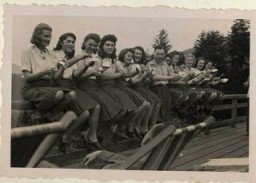
SS female auxiliaries (Helferinnen) run down a ramp in Solahütte to the music of an accordion. From Karl Höcker's photograph album, which includes both documentation of official visits and ceremonies at Auschwitz as well as more personal photographs depicting the many social activities that he and other members of the Auschwitz camp staff enjoyed. These rare images show Nazis singing, hunting, and even trimming a Christmas tree. They provide a chilling contrast to the photographs of thousands of…

SS General Reinhard Heydrich in his office during his tenure as Bavarian police chief. Munich, Germany, April 11, 1934.
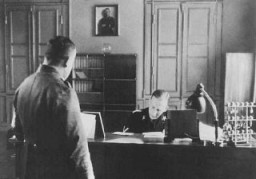
SS men search through massive piles of clothing belonging to the more than 33,000 Jews murdered at the nearby Babyn Yar killing site. The SS forced the victims to undress and leave their belongings behind. The Jews were then marched or driven to the shooting site. Kyiv (Kiev), German-occupied Soviet Union, after September 30, 1941.
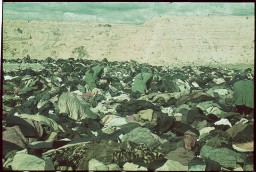
Headquarters of the SS chief at 9 Prince Albert Street. Berlin, Germany, date uncertain.
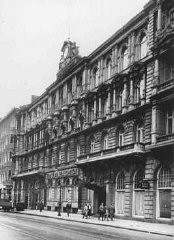
SS Lieutenant Colonel Arthur Roedl, commandant of the Gross-Rosen concentration camp. Gross-Rosen, Germany, between May 1, 1941, and September 15, 1942.
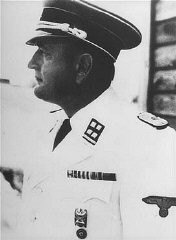
SS men guard Soviet prisoners of war doing forced labor near the Babyn Yar killing site. The photograph was taken within days of the mass murder of over 33,000 Jews on September 29-30, 1941. Kyiv (Kiev), German-occupied Soviet Union, after September 30, 1941.
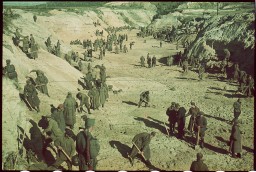
We would like to thank Crown Family Philanthropies, Abe and Ida Cooper Foundation, the Claims Conference, EVZ, and BMF for supporting the ongoing work to create content and resources for the Holocaust Encyclopedia. View the list of donor acknowledgement.